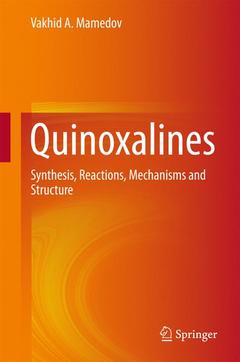Description
Quinoxalines, Softcover reprint of the original 1st ed. 2016
Synthesis, Reactions, Mechanisms and Structure
Author: Mamedov Vakhid A.
Language: English
Subjects for Quinoxalines:
Publication date: 05-2016
Support: Print on demand
Publication date: 05-2018
Support: Print on demand
Description
/li>Contents
/li>Biography
/li>Comment
/li>
This book reviews the fundamental aspects of quinoxaline chemistry: synthesis, reactions, mechanisms, structure, properties, and uses. The first four chapters present a survey of the developments in quinoxaline chemistry since the publication of the monograph on ?Condensed Pyrazines? by Cheeseman and Cookson in 1979. These chapters give comprehensive coverage of all the methods of the synthesis of quinoxalines and the important quinoxaline-containing ring systems such as thiazolo[3,4-a]-, pyrrolo[1,2-a]-, and imidazo[1,5-a]quinoxalines. Chapter five describes many new methods for the construction of quinoxaline macrocycles, which are important in applications such as optical devices and materials. The final chapter reviews all previously known rearrangements of heterocyclic systems that lead to benzimidazole derivatives. Mamedov critically analyses these transformations to reveal a novel acid-catalyzed rearrangement of quinoxalinones giving 2-heteroarylbenzimidazoles and 1-heteroarylbenzimidazolones in the presence of nucleophilic reactants (MAMEDOV Heterocycle Rearrangement). This book is of interest to researchers in the fields of heterocyclic and synthetic organic chemistry.
Introduction: Quinoxaline as a Parent Heterocycle.- Synthesis of Quinoxalines.- Synthesis of Pyrrolo[l,2-a]quinoxalines.- Synthesis of Imidazo[1,5-a]- and Imidazo[1,2-a]quinoxalines.- Synthesis of Quinoxaline Macrocycles.- Rearrangements of Quinoxalin(on)es in the Synthesis of Benzimidazol(on)es.- Appendix.
These books may interest you

Advances in Heterocyclic Chemistry 193.44 €

Advances in Heterocyclic Chemistry 203.23 €


